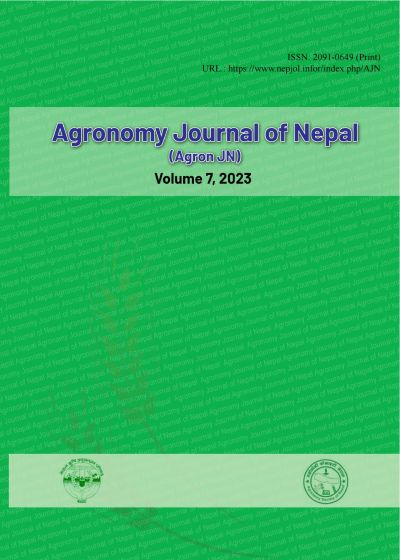Identification of Optimum Plant Population and Nitrogen Dose in Maize for Mid Hills Conditions of Nepal
DOI:
https://doi.org/10.3126/ajn.v7i1.62152Keywords:
nitrogen, row spacing, earthing up, optimization, traitsAbstract
An experiment was conducted in the summer seasons of 2021 and 2022 at the National Agronomy Research Centre's Farm Khumaltar to find out the appropriate row spacing and optimum nitrogen dose for maize. The experiment was laid out in a split plot design where nitrogen levels were allocated in the main plot and row spacing was assigned in subplots. The four different nitrogen levels were 120:60:40 N:P2O5:K2O kg ha-1, 150:60:40 N:P2O5:K2O kg ha-1, 180:60:40 N:P2O5:K2O kg ha-1 and 210:60:40 N: P2O5:K2O kg ha-1. Four different rows spacing were 75 cm, 60 cm, 50 cm and 43 cm. Seeds were sown at 25 cm apart. The individual plot size was 4m x 3m. Maize variety BGBY POP was used in the experiment. The sowing dates were 6 May and 19 May in 2021 and 2022 respectively. In the combined analysis of two-year data, days to 50% tasseling was found significant in 150:60:40 N: P2O5:K2O kg ha-1 while other traits were found non-significant. The mean grain yield was 4.29 t ha-1. Few traits were found significant in subplot factor i.e., cob diameter (4.38 cm), cob length (16.72 cm), ear height (107.1 cm) and seed per row (28.84) were found superior to other treatments within traits while all other traits in subplot factor were non-significant in pool analysis. Late maize sowing in the second year and rainfall during earthing up affected maize performance and gave lower maize yield. From the experiment, we could say that sowing of maize should be done within the second week of May and more experiments need to be done to conclude nitrogen optimization.
Downloads
Downloads
Published
How to Cite
Issue
Section
License
Copyright (c) 2023 Agronomy Society of Nepal (ASoN)

This work is licensed under a Creative Commons Attribution-NonCommercial 4.0 International License.
ASON permits for free use, distribution and reproduction in any medium if the original work is properly cited and not used for commercial purposes.




